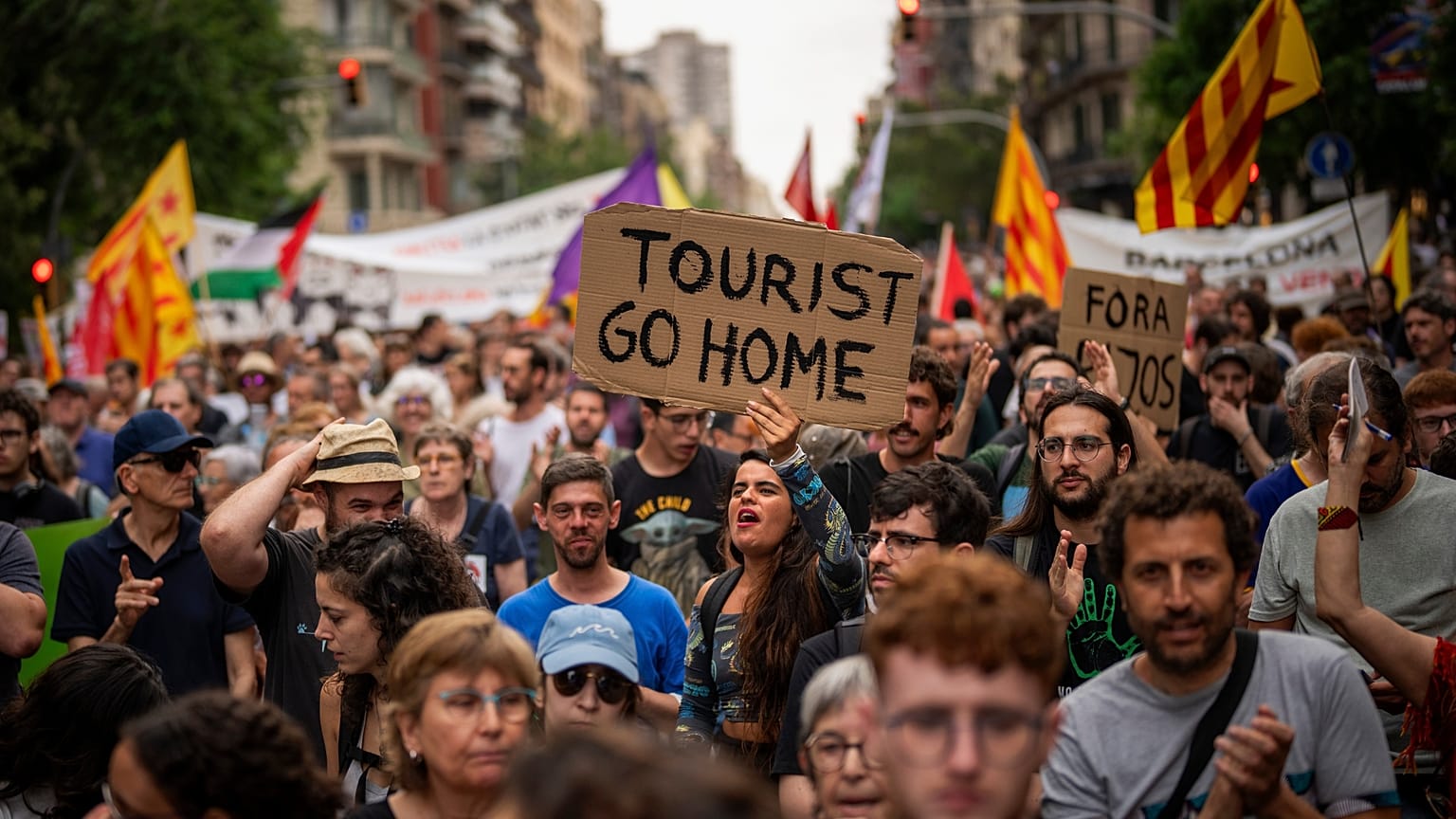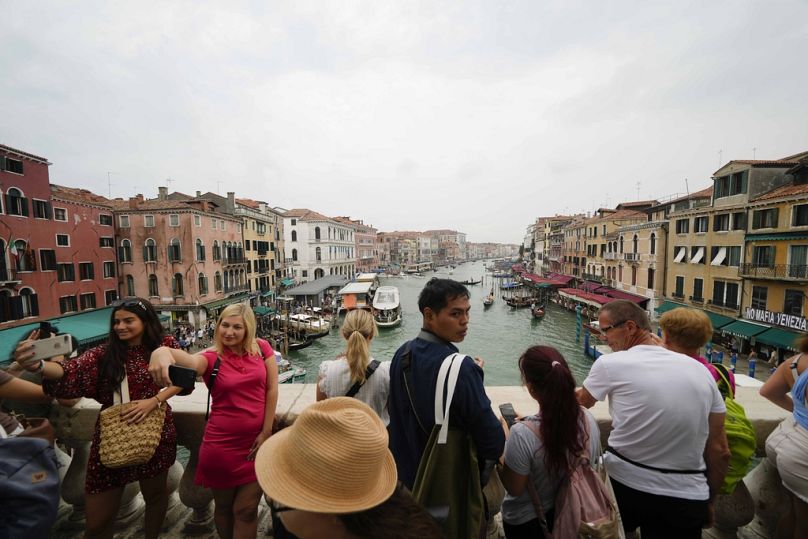Overtourism is putting pressure on health services, waste management, water supplies and housing at the expense of residents.
Thousands of Barcelona residents have taken to the streets to protest overtourism.
Around 3,000 people from over 140 organisations took to the streets of the Spanish city on Saturday afternoon, spraying tourists with water and shouting "tourists go home". Hotel and restaurant entrances were symbolically closed off.
They are calling for action before a summer season that experts say will set new records in the city and the wider region of Catalonia. Barcelona is Spain's most visited city receiving 12 million people a year, many of whom arrive via cruise ship.
Rising visitor numbers are putting pressure on health services, waste management, water supplies and housing at the expense of residents. Increased construction of hotel and housing developments is endangering historic sites, biodiversity and natural resources.
The city council has recently voted in favour of increasing its tourism tax up to €4 per person from October.
Recently, frustrations have boiled over in several other European honeypot destinations compelling local authorities to address and reassess the relationship between tourists and residents.
From outspoken graffiti to hunger strikes, here’s how destinations suffering from overtourism are pushing back.
Spain’s tourist hotspots struggle to manage housing crisis
One of the most pressing impacts of overtourism in Spain now is the lack of housing and soaring rent prices for residents.
Málaga locals expressed their frustration earlier this year by plastering the centre of the Spanish city with stickers on walls and doors, telling visitors what residents think of them.
They range from the fairly mild “this used to be my home” (antes esta era mi casa) and “this used to be the city centre” (antes esto era el centro) all the way to “go f*cking home” (a tu puta casa), “stinking of tourist” (apestando a turista).
The city on the Costa del Sol has long been a popular destination for foreign visitors, thanks to its sunny climate and relatively low cost of living. But with digital nomads now also piling in, the housing situation has become critical.
The ‘sticker initiative’ was started by bar owner Dani Drunko. Speaking to a local newspaper Diario Sur, Drunko explained that he began the campaign after he was “kicked out” of the home he’d lived in for a decade.
He claimed that the landlord refused to negotiate the rent or even sell him the property because he wanted to turn it into a short-term rental for tourists.
It is a story echoed throughout the country, where landlords have evicted long-term residents in favour of holidaymakers or pushed rents up so only high-earning digital nomads can afford them. Protests have taken place this year across the country from Ibiza to Malaga and Menorca.
The Canary Islands are experiencing a similarly drastic situation.
Activists say the over 10 million foreign visitors that holiday on the archipelago each year are ruining life there. Locals are reportedly sleeping in cars and caves due to soaring house prices.
One local organisation said the islands are “collapsing socially and environmentally” under the pressure from mass tourism.
A report from Ecologists in Action warned that almost 34 per cent of the local population - nearly 800,000 people - is at risk of poverty or social exclusion.
Residents go on hunger strike over hotel development in the Canary Islands
Constructing accommodation and services for the floods of holidaymakers to the Canaries is also putting pressure on land use, waste management, water supplies and biodiversity.
An activist group on the Canary Island of Tenerife went on hunger strike over the construction of two new hotels in April this year. They called it off after 20 days after officials showed 'zero interest' in their plight, the strikers said.
Authorities had halted work on Hotel La Tejita and Cuna del Alma in Tenerife’s Puertito de Adeje over environmental breaches but construction has recently resumed.
Canarias Se Agota (Canaries Sold Out) and Canarias se exhausta (The Canary Islands are exhausted) helped organise demonstrations on 20 April in Tenerife, Gran Canaria, Lanzarote and La Palma under the tagline ‘The Canaries have a limit’.
Tens of thousands of residents came out to protest against mass tourism with signs reading "People live here" and "We don't want to see our island die".
Demonstrators in Tenerife said they want the island to impose a limit on tourist arrivals.
"The authorities must immediately stop this corrupt and destructive model that depletes the resources and makes the economy more precarious," Antonio Bullon, one of the protest leaders, told Reuters.
“The Canary Islands have limits and people's patience too.”
Residents have also resorted to putting up fake ‘closed to overcrowding’ posters and stickers in an attempt to deter tourists in popular locations.
Venice residents protest new entry fee
Venice is another destination that has long grappled with unsustainable tourist numbers.
Again, the most damaging effect now is the ever-increasing spread of short-term rentals - as of last year, there are more tourist beds in the city than residents.
Locals are facing a shrinking pool of properties to rent and extortionate rates.
“Every day, people with very serious housing problems arrive at our desks: homeless people (often with a job), disabled people who live on high floors without a lift, people who live in damp and dilapidated houses, even declared unhygienic by the state health system,” says Susanna Polloni from the Venice-based Solidarity Network for Housing.
Venice council has earmarked €27.7 million to repair and redevelop around 500 apartments in the historic centre, islands and mainland.
But there are reportedly around 2,000 properties currently lying empty which Polloni says could have been renovated a long time ago if funds had been better managed.
Activists protested the introduction of the new €5 day-tripper entry fee on 25 April. They said they want a different vision for the city which doesn’t put tourism front and centre.
Over the first 11 days that the visitor fee was in force - from 25 April to 5 May - the city sold 195,000 tickets raising a total of €977,430. The sum greatly exceeded expectations but is still less than the cost of setting up the online booking system, informational campaigns and ticket checks - €3 million according to Italian newspaper Corriere della Sera.
Members of Venice’s Social Assembly for Housing and the Solidarity Network for Housing have criticised council spending on the day-tripper fee.
“It is a further advance towards the Venice that we do not want, the "museum city", a step towards the normalization of this image, which is all the more dangerous the more it enters the international imagination,” says Polloni.
“This measure will help make it even more concretely real. A city empty of residents and soul, given that the tourist monoculture is now devouring everything needed for the life of a city: housing, protected employment, public services, neighbourhood shops and crafts.”
After the trial period, the fee may be increased to €10 per day. There are also fines of up to €300 for those who try to visit without a ticket.
The demonstrators are just some of many Venetians who consider the housing plan drawn up by the municipality to be insufficient.
The council has said proceeds from the entry fees will go towards services that help the residents of the city including maintenance, cleaning and reducing living costs.
But critics say it will do little to moderate the influx of tourism which in turn is one of the main factors in the depopulation of Venice.
Austrian village builds fence to block tourist selfies
Last year also saw residents go to extreme measures to make their feelings heard.
The stunning backdrop to the town of Hallstatt in the Austrian mountains is thought to have inspired Disney’s Frozen.
Because of this, over a million tourists descend on the destination every year with many wanting to snap a selfie with the famous view.
Last year, residents of the town became so frustrated they put up a fence to stop visitors from taking pictures.
It was later removed due to backlash on social media but it was hoped that the barrier would prevent people from gathering in one popular selfie spot and disrupting residents by making too much noise.
Activists put up fake warning signs on Mallorca beaches
Last summer, activists put up false warning signs at beaches across Mallorca to keep English-speaking tourists away.
Some posters warned of “dangerous jellyfish”, “falling rocks” or seawater polluted with sewage.
Others said the beach was closed with a ‘no swimming’ symbol below or warned that it takes hours to walk there despite the ocean being less than 100 metres away.
A few small lines of text in Catalan underneath, however, revealed to locals that these warnings weren’t real.
They explained that “the problem isn’t a rockfall, it’s mass tourism” or that the “beach is open, except for foreigners and jellyfish.”




















